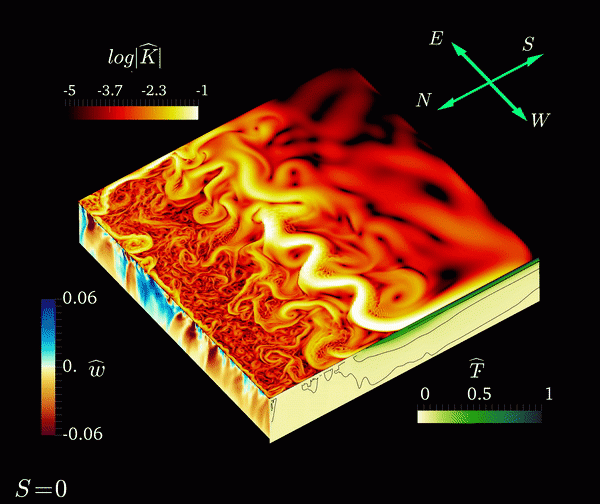The way our oceans flow – in huge circular gyres the size of continents – is an intricate effect of millimetre-sized turbulence that grows to affect global circulation patterns thousands of kilometres in length. These gyres have a major effect on daily weather, seasons and extreme weather events. Until now, they were thought to be caused solely by surface winds. In an ambitious computational study using two very different kinds of models, Dr Bishakhdatta Gayen and Professor Andy Hogg from The Australian National University have found that, amazingly, the heating and cooling of the ocean water can, on its own, cause gyres to form.
Patterns of ocean turbulence measuring in millimetres affect global circulation on the scale of tens of thousands of kilometres. No single model can accurately span that range. What the researchers did was to use two models at either end of the spectrum: direct numerical simulation that resolve the smallest effects of turbulent water, including heat transport through convection, and global models that simulate water circulation across oceans from the poles to the equator. Both classes of model require thousands of computer processors working in parallel to simulate the ocean flows and the associated variables of heat, salinity and many more.
A snapshot of Direct Numerical Simulation illustrating the character of buoyancy forced ocean gyre circulation. The horizontal plane shows normalized kinetic energy. The panel on the northern boundary shows vertical velocity. The panel on the western boundary shows the normalized temperature field. These two planes are within their respective lateral boundary layers. The elevated floating plane shows contours of mean depth‐integrated streamfunction. Gravity is oriented vertically downward, rotation is anticlockwise, and solutions are obtained at a thermally equilibrated state.
The new Gadi supercomputer at NCI is allowing researchers to scale their simulations to ever-larger domains. Early testing shows that the largest models will be able to run in parallel on more than 20,000 processor cores, or around an eighth of the entire supercomputer. Improvements in the ability of ocean models to use more processors lead to more detailed results at higher resolutions. This improves the scientific outcomes and flows through to weather and climate models that underpin much of our everyday lives.
It is stunning that heating and cooling at the ocean surface can on their own cause gyres to form. This is because there is no net kinetic energy influx, and no added momentum, going into the ocean system: the existing energy of the system is enough to generate strong, large-scale gyres. Demonstrated using two different computational approaches, the study will hopefully lead to a new paradigm in understanding ocean gyres. As the authors say, “This result represents a profound change to our understanding of one of the most fundamental aspects of the ocean's large‐scale circulation.”
You can read all about the study in this paper.
